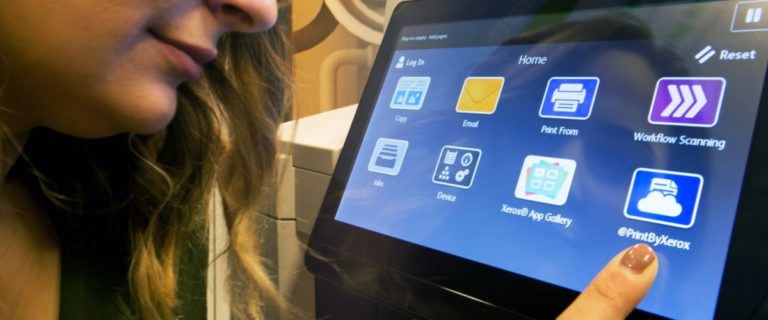By Gregory Pings

“Cliché as it may sound, our Innovation Centre provides me with the perfect work environment.”
Michael Close is responsible for everything that has to do with marketing and branding for Document Network Services. His responsibilities include design, copywriting, web development digital marketing and direct mail. The list goes on.
“I completely rely upon technology for my day-to-day work,” Close said. “I simply wouldn’t be able to do my job without a computer and my software packages.” His tools and work are on the cloud so that he can stay productive when he moves between the Innovation Centre and main office. “I always have access to everything I need.”
Located in Derby, about 90 miles south of Manchester in the United Kingdom’s Midlands, Document Network Services sells managed print services, Xerox printers and supplies, and a full array of technology and services that businesses and organizations need to succeed.
Technology for work
“We often refer to the Innovation Centre as the ‘Office of the Future,’ because it is just that,” Close explained. “The technology that we have here works together seamlessly. It provides the tools I need to get things done quicker and better than ever.”
His work area has the requisite computer and several screens, which allow him to monitor or work on multiple projects at the same time. Close’s go-to software includes Abobe Creative Cloud – mainly Illustrator, InDesign and Photoshop. They’re cloud-based, which means he can access the software and files from any computer. XMPie products allow him to create completely personalized messages for email marketing and direct mail campaigns.
You can see his work on the web at DNSlimited.co.uk. You’ll also see it in paper-based flyers, print ads, brochures, and good old-fashioned letters and marketing materials that are mailed in branded envelopes – all of which are printed in-house on a Xerox Versant 180.
What “set the page free” looks like

It is here where you can see how to set the page free. The team at DNS moves between the digital and paper realms based on the customers’ requirements and preferences.
For example, invitations to events at the Innovation Centre are personalized down to the exact image for each and every customer. Digital tools create as many (or as few) announcements as are required and send the files to printers to be completed, ready for sending to the post office. Alternatively, personalized invitations can be sent via email, depending upon the customer’s preference. RSVPs can be handled digitally, even with paper invitations. QR codes and personalized URLs allow customers to register quickly without spending money on postage nor relying on someone else to manually confirm their reservations. Personalization goes as far as the webpage that the customer arrives on, which auto populates with their contact details, making registration as simple as a click of a button.
(The Modern Workplace summer series is published each Friday on Xerox Connect. Subscribe to this blog so you won’t miss a thing, or retrieve your favorite Modern Workplace articles here.)
In an age where information is king, marketers create, manipulate and move data freely from digital to paper — and back to digital. In this age, information is created in multiple formats, and shared on multiple platforms; people receive it and act on it. New information is returned, enriched, expanded and preserved – all to be used again as required.
“Technology offers new and better ways to do the things that we already do,” Close explained. “The only offices that will exist in the future will be those that continuously invest in, and embrace, new technology.”
If that’s not a perfect work environment, then it is nearly so.



